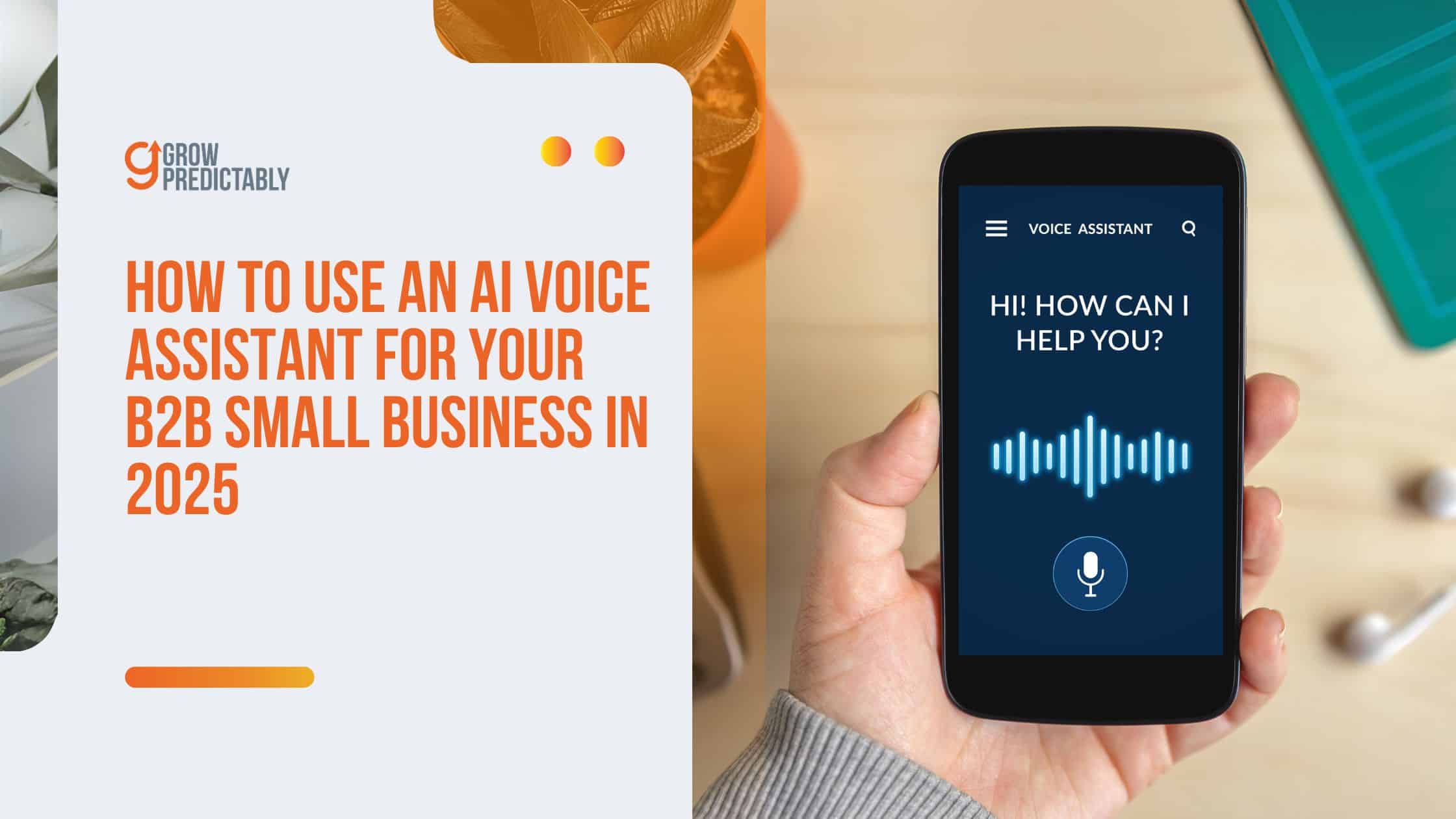How to Use an AI Voice Assistant for Small Business in 2025
Everyone’s hyping up AI voice assistants for small businesses—but what’s the real value for B2B companies?
It’s not about cutting corners.
It’s about cutting back on low-value work that buries your team.
Over 70% of voice-enabled SMBs report faster resolution times and improved client satisfaction.
Miss the integration part, though, and it all falls apart.
Curious how to avoid those mistakes—and build a system that works even while you sleep?
Keep reading!
AI Voice Assistant for Small Business: What They Are and Why They Matter for B2B
Imagine reclaiming over 30 hours per week; how drastically could your business operations transform?
For B2B small businesses overwhelmed with client interactions and countless administrative tasks, AI voice assistants are becoming indispensable allies.
AI virtual assistants work by handling a variety of tasks such as scheduling, customer service, and team communication, all without requiring any technical expertise from the user.
By leveraging these advanced tools, businesses are not just surviving—they’re thriving in a competitive landscape.
Understanding AI Voice Assistants
AI voice assistants are like having extra hands and a strategic brain in your pocket.
Employing natural language processing (NLP), these assistants recognize and respond to spoken commands to handle business tasks seamlessly.
Their user-friendly design enhances intuitive interactions and reduces the need for technical expertise.
They’re not limited to mundane activities; they can manage scheduling, correspondence, and even field routine questions, all through voice commands.
Setting reminders is a key feature of AI voice assistants, showcasing their utility in automating daily tasks and enhancing productivity.
Unlike generic automated systems, AI voice assistants are adept at grasping context, learning from ongoing interactions, and integrating fluently with your current business tools.
The Impact on B2B Small Businesses
AI voice assistants bring a transformative impact to B2B small businesses, particularly by targeting key pain points.
They significantly reduce time spent on repetitive tasks, allowing businesses to focus on more strategic activities.
My collaboration with multiple B2B firms at DigitalMarketer has unveiled their significant influence in these areas:
- Managing multiple client relationships: Juggling interactions becomes smoother, allowing focus on quality over quantity.
- Managing calendars and coordinating complex schedules: From cross-time zone meetings to periodic calls, voice assistants simplify daily operations by allowing users to manage their schedules efficiently, minimizing logistical hassle.
- Expediting follow-ups on leads: Ensures no opportunity slips through due to slow responses.
- Handling routine inquiries: Frees up human resources for high-priority tasks.
- Maintaining CRM accuracy: Reduces human error, keeping records precise and up-to-date.
The true strength of AI voice assistants lies in their ability to integrate effortlessly with critical B2B platforms like HubSpot, Salesforce, and Zoho CRM.
According to McKinsey’s 2023 AI in SMBs Report, companies utilizing integrated voice AI solutions see a 40% reduction in data entry errors and a 60% improvement in response speeds for client inquiries.
By adopting such technology, small businesses can enhance efficiency and reinforce their competitive edge in the market.
Step-by-Step Guide to Implementing AI Voice Assistants in Your B2B Small Business
Without execution, ‘vision’ is just another word for hallucination.”
Mark Hurd
Launching AI voice assistants in your business doesn’t have to feel overwhelming.
AI voice assistants, such as Amazon Alexa and Google Assistant, are incredibly versatile, especially in controlling smart home devices.
This functionality can significantly enhance productivity by streamlining daily routines and integrating smart technology into various tasks.
Here’s a straightforward guide to help you implement these powerful tools efficiently.
Step 1: Identify Business Needs
To begin, examine your current business processes to discover areas where voice automation could provide relief:
- Track Time Usage: Look at where most of your team’s hours are going, especially in repetitive client communications that automation could better manage.
- Catalog Inquiries: Keep a list of frequent questions or requests your team handles that can be automated, such as FAQs or appointment scheduling.
- Spot Bottlenecks: Identify which manual processes slow down your workflow and might benefit from automation, particularly in automating routine tasks.
Pro Tip: Target tasks that consume over 3 hours each week. Automating these will likely bring the most noticeable time savings and return on investment.
Step 2: Choose a Scalable Tool
Selecting the right platform is crucial.
A smooth initial setup is essential in creating a personalized experience for AI assistants, as meticulous input during this stage enhances functionality and voice recognition, improving performance and user efficiency.
Here’s a comparison of some popular tools:
| Tool | Best For | Starting Price | Key Feature |
| Google Dialogflow | Small teams new to AI | Free tier available | Easy integration with Google Workspace |
| Amazon Lex | Mid-sized operations | Pay-per-use | Advanced analytics |
| Kore.ai | Enterprise-ready SMBs | Custom pricing | Industry-specific templates |
Choose a platform that not only fits your current business needs but can also grow with you as your AI applications expand.
Step 3: Integration Strategy
Efficient integration ensures that your voice assistant can communicate seamlessly with the software your team already uses.
For small business owners, AI voice assistants can significantly enhance efficiency and customer service by managing tasks, improving multitasking capabilities, and providing cost-effective solutions.
No-Code Options:
- Zapier: Connect apps and automate workflows without coding, ideal for linking HubSpot, Salesforce, or Zoho CRM.
- Microsoft Power Automate: Streamline tasks through Office 365 with ease, integrating with existing operations fluidly.
- Webhooks: Use webhooks to push instant updates directly from your current systems to your voice assistant.
- Valuable Insights: These tools provide valuable insights through data analysis and decision-making, enhancing user satisfaction and service efficiency.
Low-Code Solutions:
- REST APIs: Utilize these to craft custom integrations catering to specific business requirements.
- Pre-Built Connectors: Leverage pre-built connectors from your voice assistant platform for quick deployment.
- OAuth Authentication: Secure data exchanges across applications with this standardized security protocol.
- Automate Tasks: Use low-code solutions to automate tasks such as scheduling, reminders, and controlling smart devices, enhancing productivity and allowing users to focus on more strategic initiatives.
Step 4: Customize Your AI Assistant
Design your AI assistant to best serve your industry’s specific needs:
Sample Voice Script (Logistics):
Assistant: “Welcome to [Company]. Would you like to check a shipment status or schedule a pickup?”
Client: “Check shipment status.”
Assistant: “I can help with that. Please provide your tracking number.”
AI assistants can handle complex tasks such as setting location-based reminders and analyzing data, enhancing efficiency and productivity.
[Continue dialogue flow]
Craft dialogues that feel natural and helpful, ensuring your assistant provides value while matching the brand voice.
Step 5: Team Enablement Checklist
Preparing your team is essential for a smooth transition to using AI voice assistants:
- Create an Internal Knowledge Base: Keep all helpful resources, guides, and FAQs centrally accessible.
- Hands-On Training: Plan live demonstrations and practice sessions to reduce anxiety and improve user proficiency.
- Develop Testing Scenarios: Simulate various client interactions to prepare your team for real-world applications.
- Document Best Practices: Create playbooks that outline effective use strategies and troubleshooting tips.
- Establish Feedback Loops: Encourage continuous feedback from your team to refine and enhance the system’s operation.
- Choose the Best AI Assistants: Selecting the best AI assistants can significantly enhance team productivity by personalizing user experiences and providing tailored responses, ultimately boosting business efficiency and profitability.
Quick-Start Action Items
Begin the journey by:
- Automating One Task: Pick one routine activity, like scheduling meetings or sending status updates, to automate this week.
- Starting a Free Trial: Experiment with your chosen platform to learn its capabilities.
- Building Your First Workflow: Use simple, repeatable steps to design an initial process.
- Testing with a Small Group: Assess effectiveness with a manageable client segment before rolling out widely.
- Evaluating Results: Gather data and feedback to make any necessary changes for improvement.
- Managing Your To-Do List: Utilize AI tools to efficiently manage your to-do list, freeing up time for essential tasks and enhancing overall workflow.
Remember: While it’s wise to start with a single workflow to perfect the process, always aim big.
Once confident, expand your AI footprint strategically to maximize benefits across your organization.
Mapping Voice Assistant Use Cases to the B2B Customer Value Journey
AI voice assistants unlock their full potential when strategically woven into the Customer Value Journey (CVJ).
This framework maps out the customer’s transformation from a stranger to a loyal advocate for the brand.
It’s a comprehensive system that emphasizes long-term relationship building and value delivery, ensuring a seamless navigation through each stage of the customer journey.
Understanding how AI voice assistants will evolve and adapt is crucial as we look to the future.
Businesses need to prepare for these technological advancements to remain competitive.
For B2B small businesses, often dealing with intricate buyer pathways and lean teams, here’s how voice AI can effectively enrich each stage of client relationships:
Awareness
Voice AI is a powerful tool for automating personalized outreach and initiating warm conversations.
Imagine your AI assistant scanning for trigger events like company funding announcements and initiating warm conversations: “I noticed your recent expansion. Would you like to learn how our logistics solutions support growing businesses?”
These proactive interactions lay a strong foundation for new relationships, aligning with the CVJ’s aim to raise brand awareness.
Engage
At this stage, conversational AI strengthens connections through intelligent exchanges.
Your voice assistant can:
- Answer detailed product queries 24/7, ensuring prospects always receive the information they need.
- Recommend relevant case studies aligned with each prospect’s industry, adding personalized value.
- Schedule product demos seamlessly while maintaining natural conversation flow.
- Route complex questions to the right team members, ensuring efficient problem resolution.
- Handle time-consuming responsibilities such as responding to emails and customer inquiries, thereby alleviating the burden on business owners and allowing them to focus on more critical aspects of their work.
Subscribe
Voice assistants excel at making data capture effortless.
They can:
- Convert verbal interactions into well-structured lead data.
- Set up automated email subscriptions via voice confirmation, keeping communication smooth.
- Schedule follow-up communications based on expressed interests, facilitating personalized outreach.
- Capture specific pain points for nurturing, enhancing tailored solutions delivery.
- Manage customer inquiries, relieving small business owners from handling customer communications and allowing them to focus on other crucial aspects of their operations.
This aligns with the CVJ’s emphasis on converting engaged visitors into subscribers, capturing their information for ongoing engagement.
Convert
For B2B operations, this is where voice AI truly shines.
The technology can:
- Handle meeting scheduling and rescheduling, eliminating back-and-forth emails.
- Provide instant quotes for standard services, speeding up decision-making processes.
- Configure basic product demonstrations with ease.
- Send follow-up documentation right after calls, keeping momentum alive.
- Handle routine tasks and frequently asked questions, allowing human agents to focus on more complex issues that require human intervention.
This stage corresponds with the CVJ’s aim to encourage micro-commitments from subscribers, facilitating their conversion to customers.
Excite
During onboarding, voice assistants ensure momentum continues by:
- Confirming document receipt and completion, making transitions smoother.
- Sending timely welcome sequences and setting the right tone for new clients.
- Scheduling kick-off meetings efficiently.
- Providing step-by-step guidance through initial setups, reducing friction.
- Supporting the whole team through intelligent scheduling and real-time adjustments, enhancing collaboration and productivity.
The CVJ emphasizes exceeding customer expectations here, creating memorable “aha” moments.
Ascend
Smart upselling becomes natural with AI voice assistants that can:
- Identify usage patterns suggesting enhancement needs.
- Offer relevant add-on services at optimal times.
- Schedule quarterly business reviews and maintain ongoing client relationships.
- Share success metrics that highlight the value of expansion, making the case for upgrades compelling.
- Ensure a user friendly interface, enhancing customer satisfaction and making the case for upgrades compelling.
This mirrors the CVJ’s strategy of moving customers up the value ladder with enhanced offerings, nurturing long-term loyalty.
Advocate
Voice AI turns satisfied clients into vocal advocates by:
- Automatically requesting testimonials post-positive interactions.
- Scheduling case study interviews and capturing success stories.
- Recording success metrics via casual check-ins, showcasing ongoing impact.
- Following up on Net Promoter Score (NPS) surveys with personalized thank-you notes, strengthening bonds.
- Managing calendar events to optimize task assignment and avoid conflicts, enhancing productivity.
Engaged at this stage, the CVJ seeks to leverage customer testimonials and positive feedback, turning them into brand advocates.
Promote
The journey culminates with transforming clients into active promoters.
Voice assistants help by:
- Identifying ideal referral candidates based on engagement patterns.
- Making timely referral requests, increasing the likelihood of follow-through.
- Tracking and rewarding successful referrals, encouraging ongoing participation.
- Maintaining relationships with referred leads, nurturing potential new clients.
- Integrating with other tools to provide a holistic solution for business needs.
Connecting these use cases with your existing tools amplifies their effectiveness, allowing you to fully harness the CVJ framework to optimize the customer journey and ensure a comprehensive, satisfying customer experience.
Solving Common AI Voice Challenges
Innovation is saying no to 1,000 things.”
Steve Jobs
When your AI voice system hits a wall, you need solutions that work now, not theoretical fixes.
According to PwC’s latest research, 76% of B2B companies face integration challenges with AI voice systems.
AI voice assistants can significantly enhance productivity by freeing up time and mental space for more strategic activities, such as focusing on core business operations and improving overall efficiency.
Here’s your battle plan.
1. Voice Accuracy Issues
Poor voice recognition bleeds money from your business.
MIT Technology Review reports that each incorrect interaction wastes an average of 15 minutes of productive time.
Your action plan:
- Build a custom pronunciation library for your industry terms
- Upload your actual product catalogs and terminology databases
- Start with your top 20 most-used terms first
- Feed real customer calls into the system weekly
- Run accuracy checks every 48 hours
- Ensure seamless integration with existing systems to enhance user experience and accuracy
2. Data Privacy Concerns
In B2B, data leaks kill deals. IBM Security reports that 83% of B2B companies rank data protection as their primary AI implementation concern.
Your security blueprint:
- Implement end-to-end encryption immediately
- Verify SOC 2 Type II compliance before day one
- Set clear data retention policies
- Enable automatic data anonymization
- Run monthly compliance audits
3. Team Adoption Resistance
Your team isn’t fighting technology – they’re fighting uncertainty.
Harvard Business Review shows structured adoption programs achieve 67% higher employee buy-in [https://hbr.org/2024/04/ai-adoption-patterns].
Break the resistance:
- Start with the tasks your team hates most
- Document every win, no matter how small
- Assign AI champions who use the system daily
- Roll out features based on team feedback
- Share weekly progress reports
- Utilize a virtual assistant to enhance team productivity
Measuring Your ROI with Precision
Simply having AI voice technology isn’t enough – you need to prove its worth in dollars and cents.
Here are the essential metrics you should watch:
Time Impact:
- Hours saved per employee on routine tasks
- Response time improvement percentage
- Meeting scheduling efficiency gains
- Task automation success rates
- Enhanced productivity through AI tools and virtual assistants
Cost Benefits:
- Administrative overhead reduction
- Error correction cost savings
- Customer service cost per interaction
- Training time reduction
Revenue Growth:
- Administrative overhead reduction
- Error correction cost savings
- Customer service cost per interaction
- Training time reduction
Your ROI Tracking Framework
Step 1: Baseline Metrics (Pre-Implementation)
- Document the exact time spent on tasks
- Track current error rates
- Record average response times
- Calculate current operational costs
- Emphasize the importance of integrating AI tools with existing software to enhance tracking and efficiency
Step 2: Post-Implementation Tracking
- Monitor weekly improvements
- Track automation success rates
- Measure time saved per task
- Document cost reductions
Step 3: ROI Calculation Net Benefit = (Cost Savings + Revenue Increase) – Implementation Costs ROI = (Net Benefit / Implementation Costs) x 100
Your tracking system needs to focus on numbers that impact your bottom line.
Start small, measure obsessively, and scale what works.
Every metric you track should directly connect to revenue or cost savings.
This isn’t about collecting data – it’s about proving value.
FAQs
When Conversations Become Capabilities
B2B small businesses often carry significant responsibilities with limited staff.
As outlined here, AI voice assistants aren’t just helpful—they’re transformational, eliminating friction from onboarding to referrals and replacing redundancy with results.
AI virtual assistants offer significant benefits for small businesses by managing tasks like scheduling and customer inquiries, and they promise exciting future advancements in this technology.
With the ability to directly influence engagement, data accuracy, and lead conversion, adopting voice AI is no longer optional—it’s essential for modern customer journeys.
Ready to run smarter operations?
Start your journey with the Voice AI QuickStart Guide and experiment with platforms like Lex or Kore.ai.
Which customer interaction would you automate first to create more space for growth?
By embracing AI voice technology, your small business positions itself alongside more prominent players, not just by adapting, but by evolving.
Let your voice assistant handle the talking—so you can focus on leading.








